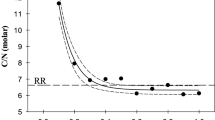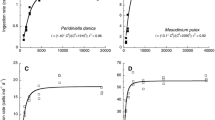Abstract
Viscosity increases significantly with a fall in water temperature, thus temperature change affects not only the metabolic rates of aquatic suspension feeders, but also the physical properties of the surrounding fluid. This mechanistic effect of water temperature change on growth was separated from the effect of metabolism by using culture media with modified viscosity, while the temperature was kept constant. The effect of water viscosity on growth rate and feeding of four Daphnia species (D. magna, D. pulicaria, D. hyalina, D. galeata) was investigated. Increased viscosity decreased the growth rate significantly for three species, with the exception of D. galeata. Changing viscosity also affects growth qualitatively: the filamentous blue-green Cylindrospermopsis raciborskii reduces the growth rate of D. pulicaria at low viscosity, but its negative effect disappears when viscosity is higher. The findings are consistent with the hypothesis that it is the Reynolds number of the filtering appendages that determines the qualitative features of Daphnia filtration. The edibility of C. raciborskii at high water viscosity is most probably caused by lack of interference with filtering combs, and explains the coexistence of D. pulicaria with filamentous blue-green species in the field, and also the observed temperature dependence of growth inhibition of filaments.




Similar content being viewed by others
References
Berg HC, Turner L (1979) Movement of microorganisms in viscous environments. Nature 278:349–351
Bolton TF, Havenhand JN (1998) Physiological versus viscosity induced effect of an acute reduction in water temperature on microsphere ingestion by trochophore larvae of the serpulid polychaete Galeolaria caespitosa. J Plankton Res 20:2153–2164
Brendelberger H (1988) Untersuchungen zur funktionsmorpholgie des filterapparates von Cladoceren. PhD thesis. Christian-Albrechts University, Germany
Brendelberger H (1991) Filter mesh size of cladocerans predicts retention efficiency for bacteria. Limnol Oceanogr 36:884–894
Brendelberger H, Geller W (1985) Variability of filter structures in eight Daphnia species: mesh sizes and filtering areas. J Plankton Res 7:473–486
DeMott WR, Gulati RD, Van Donk E (2001) Daphnia food limitation in three hypereutrophic Dutch lakes: evidence for exclusion of large-bodied species by interfering filaments of cyanobacteria. Limnol Oceanogr 46:2054–2060
Epp GT (1996) Grazing on filamentous cyanobacteria by Daphnia pulicaria. Limnol Oceanogr 41:560–567
Geller W, Müller H (1981) The filtration apparatus of Cladocera: filter mesh sizes and their implications on food selectivity. Oecologia 49:316–321
Gerritsen J, Porter KG, Strickler JR (1988) Not by sieving alone: observations of suspension feeding in Daphnia. Bull Mar Sci 43:336–376
Gliwicz ZM, Lampert W (1990) Food thresholds in Daphnia species in the absence and presence of blue green filaments. Ecology 71:691–702
Gophen M, Geller W (1984) Filter mesh size and food particle uptake by Daphnia. Oecologia 64:408–412
Hagiwara A, Yamamiya N, Belem de Araujo A (1998) Effect of water viscosity on the population growth of the rotifer Brachionus plicatilis Muller. Hydrobiologia 388:489–494
Hawkins P, Lampert W (1989) The effect of Daphnia body size on filtering rate inhibition in the presence of a filamentous cyanobacterium. Limnol Oceanogr 34:1084–1089
Hawkins PR, Putt E, Falconer I, Humpage A (2001) Phenotypical variation in a toxic strain of the phytoplankter, Cylindrospermopsis raciborskii (Nostocales, Cyanophyceae) during batch culture. Environ Toxicol 16:460–467
Kasprzak P, Lathrop RC, Carpenter SR (1999) Influence of different sized Daphnia species on chlorophyll concentration and summer phytoplankton community structure in eutrophic Wisconsin lakes. J Plankton Res 21:2161–2174
Kirk KL, Gilbert JJ (1992) Variations in herbivore response to chemical defenses: zooplankton foraging on toxic cyanobacteria. Ecology 73:2208–2217
Koehl MAR (1996) When does morphology matter? Annu Rev Ecol Syst 27:501–542
Kurmayer R (2001) Competitive ability of Daphnia under dominance of non-toxic filamentous Cyanobacteria. Hydrobiologia 442:279–289
Lampert W (1981) Inhibitory and toxic effects of blue-green algae on Daphnia. Int Rev Ges Hydrobiol 66:285–298
Loiterton B, Sundbom M, Vrede T (2004) Separating physical and physiological effects on zooplankton feeding rate. Aquat Sci 66:123–129
Lynch M (1980) Aphanizomenon blooms: alternate control and cultivation by Daphnia pulex. In: Kerfoot WC (ed) The evolution and ecology of zooplankton communities. University Press of New England, Hanover, N.H.
Paterson MJ, Findlay DL, Salki AG, Hendzel LL, Hesslein RH (2002) The effects of Daphnia on nutrient stoichiometry and filamentous cyanobacteria: a mesocosm experiment in a eutrophic lake. Freshwater Biol 47:1217–1233
Podolsky RD (1994) Temperature and water viscosity: physiological versus mechanical effects on suspension feeding. Science 265:100–103
Porter KG, Feig YS, Vetter EF (1983) Morphology, flow regimes and filtering rates of Daphnia, Ceriodaphnia, and Bosmina fed natural bacteria. Oecologia 58:156–163
Stich HB, Lampert W (1984) Growth and reproduction of migrating and non migrating Daphnia species under simulated food and temperature conditions of diurnal vertical migration. Oecologia 61:192–196
Threlkeld ST (1986) Differential temperature sensitivity of two cladoceran species to resource variation during a blue-green algal bloom. Can J Zool 64:1739–1744
Vogel S (1994) Life in moving fluids—the physical biology of flow. Princeton University Press, Princeton, N.J.
Von Elert E, Martin-Creuzburg D, Le Coz JR (2003) Absence of sterols constrains carbon transfer between cyanobacteria and a freshwater herbivore (Daphnia galeata). Proc R Soc Lond B 270:1209–1214
Acknowledgement
The research was supported by grants from KBN (6PO4F 04717) to György Abrusán and Piotr Dawidowicz (6PO4F 01821).
Author information
Authors and Affiliations
Corresponding author
Electronic Supplementary Material
Rights and permissions
About this article
Cite this article
Abrusán, G. Filamentous cyanobacteria, temperature and Daphnia growth: the role of fluid mechanics. Oecologia 141, 395–401 (2004). https://doi.org/10.1007/s00442-004-1660-x
Received:
Accepted:
Published:
Issue Date:
DOI: https://doi.org/10.1007/s00442-004-1660-x




